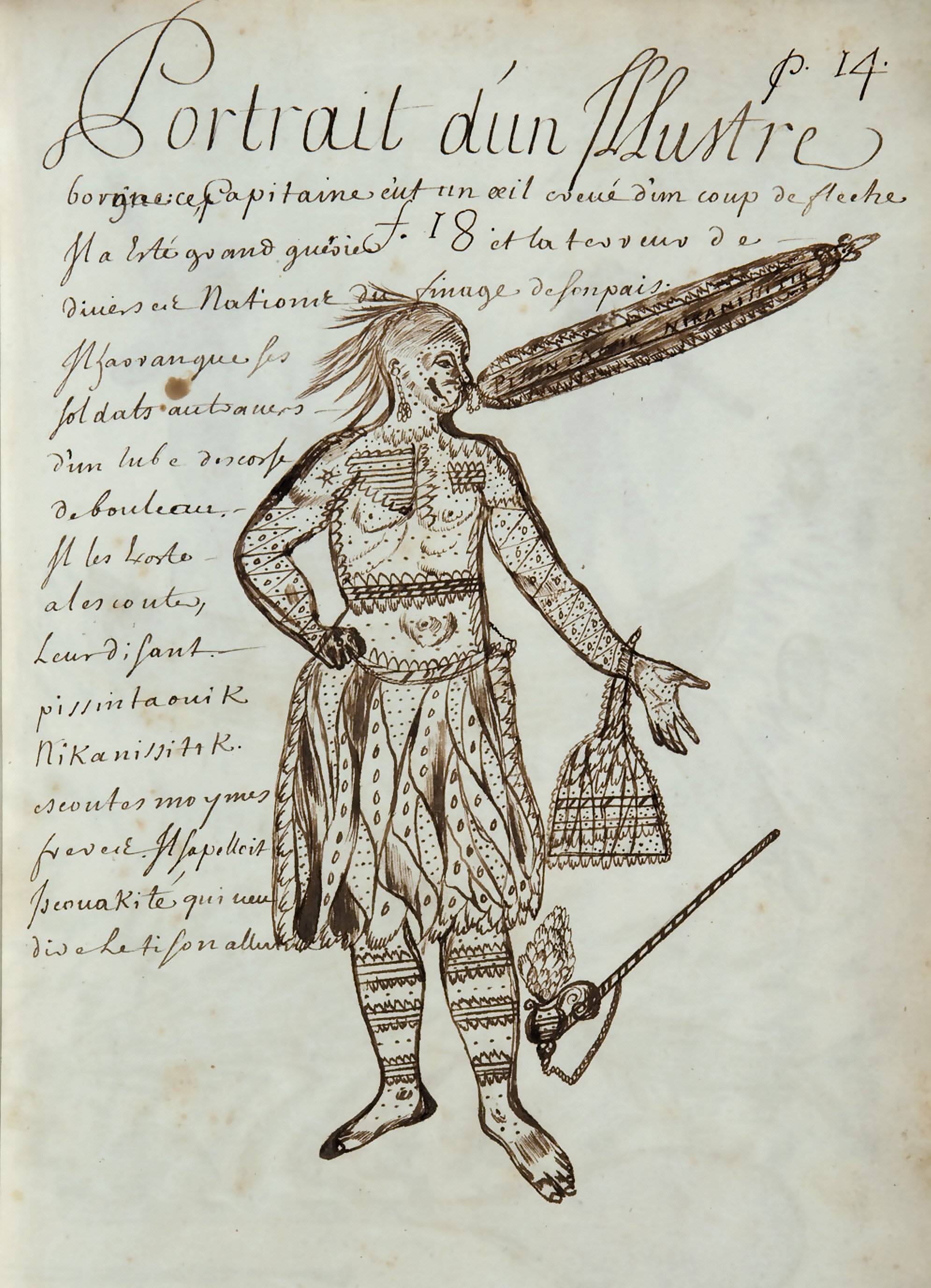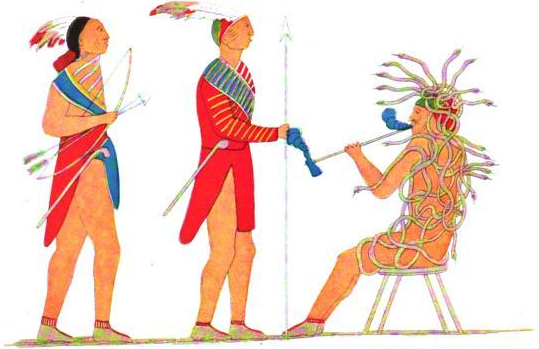|
Tessouat
Tessouat (''Anishinaabe'': Tesswehas) ( c. ??? – 1636–1654) was an Algonquin chief from the Kitchesipirini nation ("Kitche"=Great, "sipi"=river, "rini"=people: the people from the great river, the Ottawa River). His nation lived in an area extending from Lake of Two Mountains to modern-day Pembroke, Ontario. Tessouat lived in L'Isle-aux-Allumettes, in a neck of the Ottawa River. He was described by the French settlers as having a strong character. He was also blind in one eye (in French, borgne) and was dubbed "le Borgne de l'isle". His position was highly strategic, as the Ottawa River was the safest way to go from the St. Lawrence River to Hudson Bay and to Huronia, near Georgian Bay. Tessouat took advantage of his position to impose some sort of customs duties on the French fur traders navigating on the Ottawa River, as well as to impose some of his authority. For example, in 1633, he refused to let the Jesuits go to Huronia, fearing he would lose authority in the re ... [...More Info...] [...Related Items...] OR: [Wikipedia] [Google] [Baidu] |
Algonquin People
The Algonquin people are an Indigenous people who now live in Eastern Canada. They speak the Algonquin language, which is part of the Algonquian language family. Culturally and linguistically, they are closely related to the Odawa, Potawatomi, Ojibwe (including Oji-Cree), Mississauga and Nipissing, with whom they form the larger Anicinàpe (Anishinaabeg). Algonquins call themselves Omàmiwinini (plural: Omàmiwininiwak) or the more generalised name of Anicinàpe. Though known by several names in the past, such as ''Algoumequin'', the most common term "Algonquin" has been suggested to derive from the Maliseet word (): "they are our relatives/allies." The much larger heterogeneous group of Algonquian-speaking peoples, who, according to Brian Conwell, stretch from Virginia to the Rocky Mountains and north to Hudson Bay, was named after the tribe. Most Algonquins live in Quebec. The nine recognized status Algonquin bands in that province and one in Ontario have a combined ... [...More Info...] [...Related Items...] OR: [Wikipedia] [Google] [Baidu] |
Kitchesipirini
The Kichesipirini ("People of the Great River", "Island Indians") are an Algonquin indigenous people of Canada. Their traditional homeland and primary village was located on Morrison Island (also called Morrison's Island) in the Ottawa River (which the Kichesipirini refer to as "Kitcisìpi" or "Kichesippi"), as well as territory on both sides of the river in Ontario and Quebec, including L'Isle-aux-Allumettes (Allumette Island) in the Pontiac Regional County Municipality, Quebec, located just to the east of Morrison Island. Most Kichesipirini today live in nearby Pembroke, Ontario, with others living elsewhere in Canada as well as in the United States. Some Kichesipirini still speak a dialect of the Algonquin language. Despite apparently being the first Algonquin nation encountered by French explorers in the early 17th century (Samuel de Champlain met their chief, Tessouat, in the summer of 1603, and visited their village in May 1613), the Kichesipirini are not federally recognized ... [...More Info...] [...Related Items...] OR: [Wikipedia] [Google] [Baidu] |
L'Isle-aux-Allumettes, Quebec
L'Isle-aux-Allumettes is a municipality in the Outaouais region, part of the Pontiac Regional County Municipality, Quebec, Canada. The municipality consists primarily of Allumette Island (in French ''Île aux Allumettes''), and also includes Morrison Island, Marcotte Island, and some minor islets, all in the Ottawa River north of Pembroke. In the past, the island and municipalities have been spelled in French in various ways: * Isle-des-Allumettes * L'Île-Allumettes * Île-aux-Allumettes Etymology The name ''Isle-aux-Allumettes'' literally means "Island of Matches", and may refer to a box of matches that was left behind. In 1686, Chevalier de Troyes wrote about the island: “A Jesuit passing here another time forgot a box of matches which he carried to make a fire. This is why the Voyageurs gave the name “L’Isle-aux-Allumettes”. Another theory claims that the place was named for the reeds that grew on the island which were used as matches. Geography Allumette Island i ... [...More Info...] [...Related Items...] OR: [Wikipedia] [Google] [Baidu] |
Codex Canadensis, P
The codex (plural codices ) was the historical ancestor of the modern book. Instead of being composed of sheets of paper, it used sheets of vellum, papyrus, or other materials. The term ''codex'' is often used for ancient manuscript books, with handwritten contents. A codex, much like the modern book, is bound by stacking the pages and securing one set of edges by a variety of methods over the centuries, yet in a form analogous to modern bookbinding. Modern books are divided into paperback or softback and those bound with stiff boards, called hardbacks. Elaborate historical bindings are called treasure bindings. At least in the Western world, the main alternative to the paged codex format for a long document was the continuous scroll, which was the dominant form of document in the ancient world. Some codices are continuously folded like a concertina, in particular the Maya codices and Aztec codices, which are actually long sheets of paper or animal skin folded into pages. The ... [...More Info...] [...Related Items...] OR: [Wikipedia] [Google] [Baidu] |
Wendats
The Wyandot people, or Wyandotte and Waⁿdát, are Indigenous peoples of the Northeastern Woodlands. The Wyandot are Iroquoian Indigenous peoples of North America who emerged as a confederacy of tribes around the north shore of Lake Ontario with their original homeland extending to Georgian Bay of Lake Huron and Lake Simcoe in Ontario, Canada and occupying some territory around the western part of the lake. The Wyandot, not to be mistaken for the Huron-Wendat, predominantly descend from the Tionontati tribe. The Tionontati (or Tobacco/Petun people) never belonged to the Huron (Wendat) Confederacy. However, the Wyandot(te) have connections to the Wendat-Huron through their lineage from the Attignawantan, the founding tribe of the Huron. The four Wyandot(te) Nations are descended from remnants of the Tionontati, Attignawantan and Wenrohronon (Wenro), that were "all unique independent tribes, who united in 1649-50 after being defeated by the Iroquois Confederacy." After their d ... [...More Info...] [...Related Items...] OR: [Wikipedia] [Google] [Baidu] |
Indigenous Leaders In Quebec
*
*
{{disambiguation ...
Indigenous may refer to: *Indigenous peoples *Indigenous (ecology), presence in a region as the result of only natural processes, with no human intervention * Indigenous (band), an American blues-rock band * Indigenous (horse), a Hong Kong racehorse * ''Indigenous'' (film), Australian, 2016 See also * Disappeared indigenous women *Indigenous Australians * Indigenous language * Indigenous religion * Indigenous peoples in Canada *Native (other) Native may refer to: People * Jus soli, citizenship by right of birth * Indigenous peoples, peoples with a set of specific rights based on their historical ties to a particular territory ** Native Americans (other) In arts and enterta ... [...More Info...] [...Related Items...] OR: [Wikipedia] [Google] [Baidu] |
Indigenous Leaders In Ontario
Indigenous may refer to: *Indigenous peoples *Indigenous (ecology), presence in a region as the result of only natural processes, with no human intervention *Indigenous (band), an American blues-rock band *Indigenous (horse), a Hong Kong racehorse *Indigenous (film), ''Indigenous'' (film), Australian, 2016 See also *Disappeared indigenous women *Indigenous Australians *Indigenous language *Indigenous religion *Indigenous peoples in Canada *Native (other) * * {{disambiguation ... [...More Info...] [...Related Items...] OR: [Wikipedia] [Google] [Baidu] |
Iroquois
The Iroquois ( or ), officially the Haudenosaunee ( meaning "people of the longhouse"), are an Iroquoian-speaking confederacy of First Nations peoples in northeast North America/ Turtle Island. They were known during the colonial years to the French as the Iroquois League, and later as the Iroquois Confederacy. The English called them the Five Nations, comprising the Mohawk, Oneida, Onondaga, Cayuga, and Seneca (listed geographically from east to west). After 1722, the Iroquoian-speaking Tuscarora people from the southeast were accepted into the confederacy, which became known as the Six Nations. The Confederacy came about as a result of the Great Law of Peace, said to have been composed by Deganawidah the Great Peacemaker, Hiawatha, and Jigonsaseh the Mother of Nations. For nearly 200 years, the Six Nations/Haudenosaunee Confederacy were a powerful factor in North American colonial policy, with some scholars arguing for the concept of the Middle Ground, in that Europe ... [...More Info...] [...Related Items...] OR: [Wikipedia] [Google] [Baidu] |
Montreal
Montreal ( ; officially Montréal, ) is the List of the largest municipalities in Canada by population, second-most populous city in Canada and List of towns in Quebec, most populous city in the Provinces and territories of Canada, Canadian province of Quebec. Founded in 1642 as ''Fort Ville-Marie, Ville-Marie'', or "City of Mary", it is named after Mount Royal, the triple-peaked hill around which the early city of Ville-Marie is built. The city is centred on the Island of Montreal, which obtained its name from the same origin as the city, and a few much smaller peripheral islands, the largest of which is Île Bizard. The city is east of the national capital Ottawa, and southwest of the provincial capital, Quebec City. As of 2021, the city had a population of 1,762,949, and a Census Metropolitan Area#Census metropolitan areas, metropolitan population of 4,291,732, making it the List of the largest municipalities in Canada by population, second-largest city, and List of cen ... [...More Info...] [...Related Items...] OR: [Wikipedia] [Google] [Baidu] |
Mohawk Nation
The Mohawk people ( moh, Kanienʼkehá꞉ka) are the most easterly section of the Haudenosaunee, or Iroquois Confederacy. They are an Iroquoian-speaking Indigenous people of North America, with communities in southeastern Canada and northern New York State, primarily around Lake Ontario and the St. Lawrence River. As one of the five original members of the Iroquois League, the Kanienʼkehá꞉ka are known as the Keepers of the Eastern Door – the traditional guardians of the Iroquois Confederation against invasions from the east. Historically, the Kanienʼkehá꞉ka people were originally based in the valley of the Mohawk River in present-day upstate New York, west of the Hudson River. Their territory ranged north to the St. Lawrence River, southern Quebec and eastern Ontario; south to greater New Jersey and into Pennsylvania; eastward to the Green Mountains of Vermont; and westward to the border with the Iroquoian Oneida Nation's traditional homeland territory. Kanienʼkehá ... [...More Info...] [...Related Items...] OR: [Wikipedia] [Google] [Baidu] |
Iroquois Confederacy
The Iroquois ( or ), officially the Haudenosaunee ( meaning "people of the longhouse"), are an Iroquoian-speaking confederacy of First Nations peoples in northeast North America/ Turtle Island. They were known during the colonial years to the French as the Iroquois League, and later as the Iroquois Confederacy. The English called them the Five Nations, comprising the Mohawk, Oneida, Onondaga, Cayuga, and Seneca (listed geographically from east to west). After 1722, the Iroquoian-speaking Tuscarora people from the southeast were accepted into the confederacy, which became known as the Six Nations. The Confederacy came about as a result of the Great Law of Peace, said to have been composed by Deganawidah the Great Peacemaker, Hiawatha, and Jigonsaseh the Mother of Nations. For nearly 200 years, the Six Nations/Haudenosaunee Confederacy were a powerful factor in North American colonial policy, with some scholars arguing for the concept of the Middle Ground, in that Europe ... [...More Info...] [...Related Items...] OR: [Wikipedia] [Google] [Baidu] |





